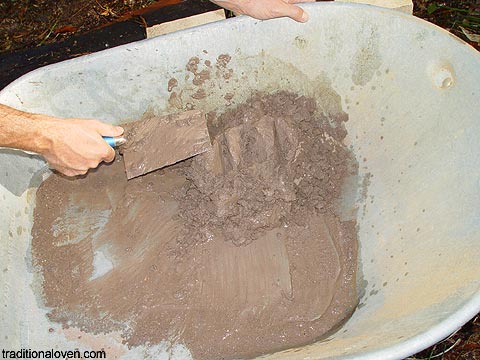I want to caution everyone up front that lime is nasty nasty stuff. I wore a good particle mask, glasses, and nitrite gloves. Thinking I should have used a better mask.
From: Traditional Oven
Refractory mortar mixing formulas
10 : 3 : 1.5 - Sand, Calcium Aluminate cement, Fireclay.
If you found hard locating refractory cement don't worry, here is one mixing formula with Portland cement plus lime available in ordinary building stores.
There are two Portland cement types, get the common gray in color, the other one is white decorative used for around pools etc. where a white effects are required.
Lime is calcium it takes over the cement in hot conditions (Portland will gradually burn out, it is used only for the mortar to set while working.)
10 : 6 : 2 : 3 – Sand, Fire Clay, Portland cement, and Lime.

First mix all dry ingredients well. Then in small amounts start adding clean water at room temperature while continuing mixing.
Mix into peanut butter consistency.
and...
Mix it in wheelbarrow or straight in a bucket. After mortar looks mixed well, leave it for couple of minutes and then remix one more time. It will have slight thicker consistency after 2 mins., you may have to add a SPOON of water and mix to a peanut butter consistency. Prepare smaller quantity at the time, e.g. for one dome arch. Amount on the picture is nearly for all 3 aches, for making complete rectangular dome ceiling. ... Hoy, Rado that stuff looks quite mushy in there, oi it is mushy is it not? ... Oy ye, ye mate it is mushy, it always is mushy, ye.
The key info is "Lime is calcium it takes over for the cement in hot conditions (Portland will gradually burn out, it is used only for the mortar to set while working.)"
Now I wonder if the strength of the Portland cement bond matters. And how long is "gradually" If the cement bonds remain in the outer, cooler, part of the shell then it should. But no idea if that is true. May vary from one furnace design to the next.
According to the text the lime bond withstands heat better than the Portland cement but does not give numbers.
Heat-resistant concrete ingredients & the mixing formula:
Firebrick Grog (crushed fire bricks) or gravel from river with sand
Refractory cement (e.g. Calcium Aluminate cement. If available in different grades choose the better one)
Lime (lime is usually cheaper, about 80% of the cement price. Lime applies if you use Portland cement type)
Water
Refractory cement (e.g. Calcium Aluminate cement. If available in different grades choose the better one)
Lime (lime is usually cheaper, about 80% of the cement price. Lime applies if you use Portland cement type)
Water
With the heat resistant concrete type mixed with Portland you can add into this mix a little standard Fireclay if you like.
Mixture: (parts ratio is 3 x 2 x 2 x 0.5, plus water)
3 shovels of the gravel or grog/crushed firebricks
2 shovels of sand (Portland concrete type only)
2 shovels of the cement
1/2 shovel of lime (for Portland concrete type)
This amount will require approximately 6-7 liters of water to mix the concrete.
3 shovels of the gravel or grog/crushed firebricks
2 shovels of sand (Portland concrete type only)
2 shovels of the cement
1/2 shovel of lime (for Portland concrete type)
This amount will require approximately 6-7 liters of water to mix the concrete.
No comments:
Post a Comment